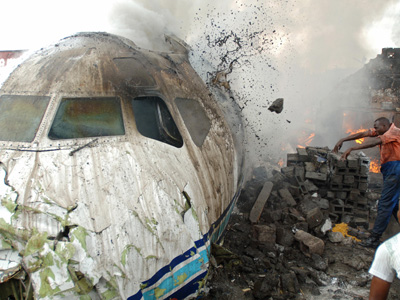
Do planes crash because of the culture of the people flying them? Malcolm Gladwell, whose speech aired today on the first hour of Midday, certainly thinks so. We live, of course, in an area with a lot of airline pilots so I’ll defer to them. But I have to think there’s going to be a lot of reaction to Gladwell’s assertion that airline tragedies have a certain ethnic basis.
During his speech, given at the New Yorker Festival in October , Gladwell referred to a section of his new book, “Outliers: The Story of Success,” in which he analyzes airline crashes and determines that pilots from certain cultures tend to crash planes more than others. Some cultures are better at communicating than others.
And he acknowledges that his conclusion is uncomfortable. It’s also very debatable.
“Look at where the countries with the safest rate of airline travel are,” he says near the end of his address. “The United States, Australia, and the United Kingdom.” He reasoned that people in those countries are culturally more inclined to communicate better as a matter of character and personality.
As he said in a CNN interview:
Korean Air had more plane crashes than almost any other airline in the world for a period at the end of the 1990s. When we think of airline crashes, we think, Oh, they must have had old planes. They must have had badly trained pilots. No. What they were struggling with was a cultural legacy, that Korean culture is hierarchical. You are obliged to be deferential toward your elders and superiors in a way that would be unimaginable in the U.S.
Let’s ignore for now that one of those Korean Air jets got shot out of the sky. But what Gladwell didn’t point out is that English is the official — mandated — language of aviation on international flights. When you remove the international flights from the accident database, the gap between the English-as-a-first language countries and those who aren’t speaking their native tongue closes. Isn’t it at least possible that the reason there’s a communication problem isn’t that there’s a cultural problem, it’s that there’s a lack of mastery of the language being mandated?
Gladwell used an example of this without saying so: The Avianca Flight 52 crash on Long Island. Gladwell relayed the communications in the cockpit and with the controllers for Kennedy Airport, but he never mentioned they were speaking two different languages. The flight crashed because the jet ran out of fuel and the controllers never realized there was an emergency in the first place.
According to a 1990 article in the New York Times:
A captain for Avianca Airlines told Federal investigators today that the company did not train its flight crews to use specific words in asking air traffic controllers for priority treatment when a plane was running out of fuel.
Again, those are international standards that weren’t followed, more of a sign of bad training and a bad airline than a bad culture. But it was more than even that, according to the National Transportation Safety Board. The plane crashed because the pilots (a) didn’t manage their fuel (b) didn’t communicate their situation soon enough (c) failed to follow airline “operational control dispatch system to assist them.” And it crashed because the FAA didn’t have a standardized understandable terminology for pilots and controllers in the given situation. Also cited was (a) windshear (b) crew fatigue and (c) stress.
In other words, a lot more than culture went into that tragedy.
But one assertion which I’m waiting for the local airline pilot community to confirm — or deny — is Gladwell’s statement that, “in an emergency, the safest system is one in which the co-pilot does the flying.” He suggested that it would be the more senior officer who would be able to decide the best course of action, and monitor the situation, if he wasn’t burdened with actually flying.
And it’s true that an old axiom in aviation is when there’s an emergency, the first thing to do is wind your watch (I told you it was “old”), because that gives you time to think.
But the greatest pilot in the history of aviation may be Al Haynes. He was at the controls of a United DC-10 whe it lost all of its hydraulics. It cartwheeled at the Sioux City airport on landing.
By all accounts, Haynes, his crew, and all passengers should’ve died. But 185 survived. Why? Haynes talked to and listened to as many pieces of advice as was available to him. It’s something Gladwell touched on too briefly. It’s called “cockpit resource management,” and it’s when the pilot and co-pilot are operating on the same page and the junior officer isn’t afraid to question the senior officer’s decision. (Aside: There’s a pilot in Minneapolis who writes a terrific blog, “Blogging at FL250,” who touched on the relationship between flying pilots. It’s well worth a read.)
Minnesota’s two most recent high-profile plane crashes were both examples of CRM gone bad. In December 1993, 16 passengers and two pilots were killed when a Northwest Airlink plane crashed in Hibbing.
The co-pilot tried to alert the captain about the altitude of the plane while executing a banned maneuver. “The captain’s record raised questions about the adequacy of his airmanship and behavior that suggested a lack of crew coordination during flight operations, including intimidation of first officers,” the National Transportation Safety Board concluded in its investigation. (Also see a New York Times article on the crash.)
And in 2002, the airplane carrying Sen. Paul Wellstone and members of his family and campaign, crashed in Virginia-Eveleth because, the NTSB said, the pilots had violated several policies and, basically, didn’t pay attention to basic airmanship to keep the plane from stalling and crashing.
More often than not, that, and not the culture of a pilot, is why airplane’s crash. Pilots make mistakes
(Photo: Getty Images)
